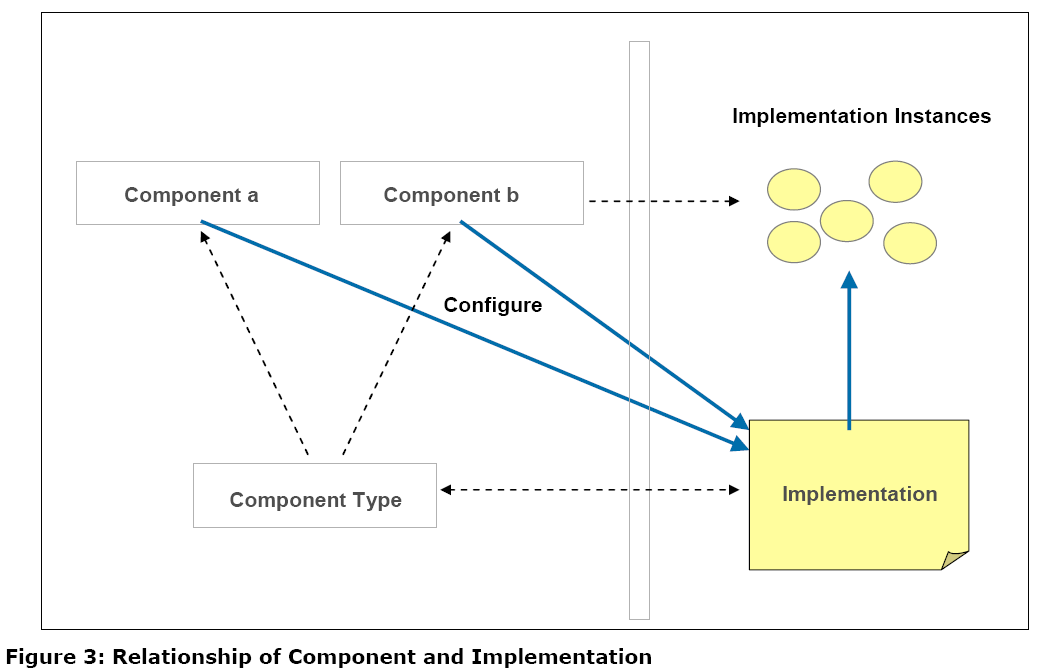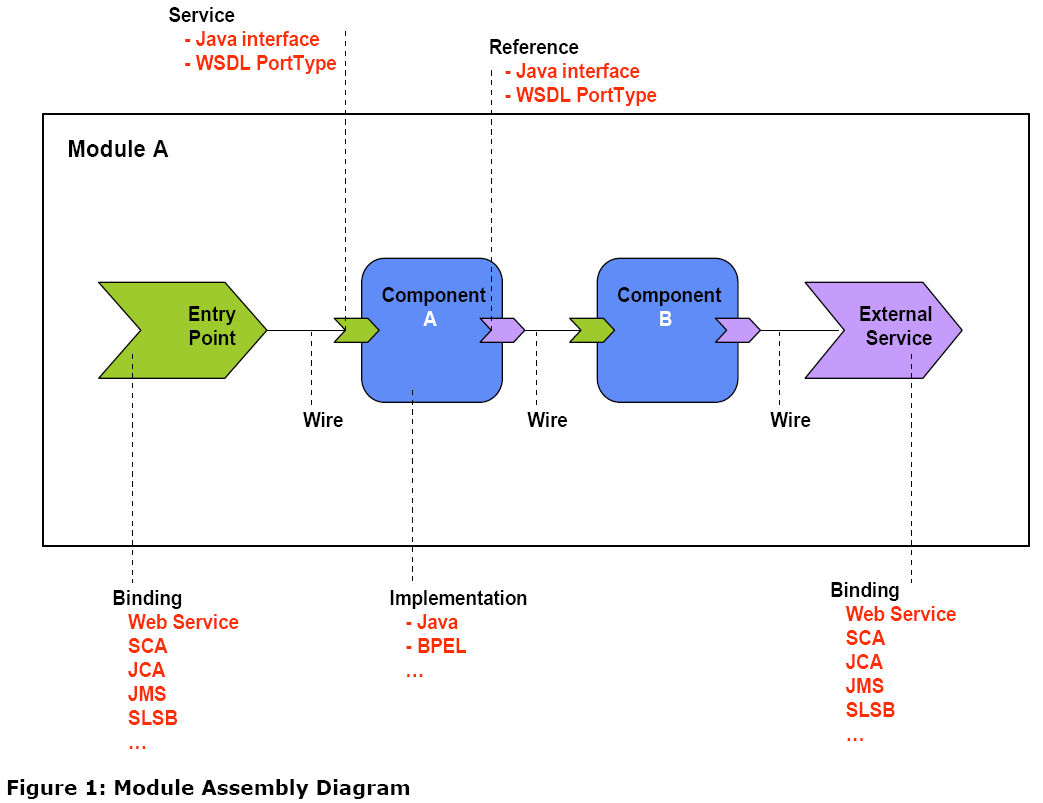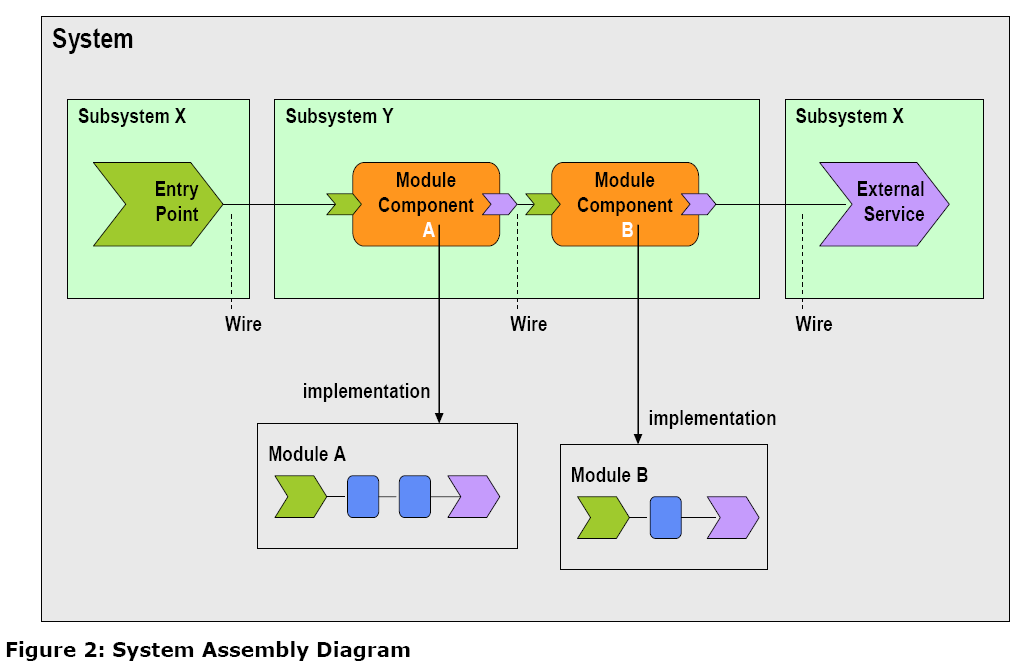
2006年4月25日
SCA
Module是紧耦合component的最大的组合物,同时也是松耦合SCA
System中的基本单元,也就是说,很多紧耦合的东东组成Module,然后很多Module组成松耦合的System。我们都知道一味的紧耦合及松耦
合都是不好的,过分的紧耦合会降低系统的灵活性、可重用性等,而过分的松耦合会导致系统性能的下降、开发难度增加、代码不直观、测试难做等,因此,选择一
个合适的紧耦合和松耦合之间的临界点是很重要的,而Module就是这个临界点。
Module有如下几个标准特性:
-
定义了Component可见性的边界,Component不可以在Module之外直接被引用。
-
在同一个Module内,Service的本地调用采用by-reference语义(除了声明为remotable的接口)。在Module之间,Service的远程调用采用by-value语义。
-
定义了部署的单元。Module用来为SCA System提供business service。
Module由sca.module中的module元素定义。下面是module的schema:
<?xml version="1.0" encoding="ASCII"?>
<module xmlns=”http://www.osoa.org/xmlns/sca/0.9”
xmlns:v="http://www.osoa.org/xmlns/sca/values/0.9" name="xs:NCName">
<entryPoint name="xs:NCName" multiplicity="0..1 or 1..1 or 0..n or 1..n" ?>*
<interface.interface-type />
<binding.binding-type uri="xs:anyURI" />+
<reference>wire-target-URI</reference>
</entryPoint>
<component name="xs:NCName">*
<implementation.implementation-type />
<properties>?
<v:property-name>property-value</v:property-name>+
</properties>
<references>?
<v:reference-name>wire-target-URI</v:reference-name>+
</references>
</component>
<externalService name="xs:NCName">*
<interface.interface-type />+
<binding.binding-type uri="xs:anyURI" />*
</externalService>
<wire>*
<source.uri>wire-source-URI</source.uri>
<target.uri>wire-target-URI</target.uri>
</wire>
</module>
<
module
/>
的name属性表示module的名字,在一个SCA System中是唯一的。这个名字不能包含/或#字符。
<
module
/>
包含0或n个
<
entryPoint
/>
、
<
component
/>
、
<
externalService
/>
、 <wire />元素,这些元素的含义在之前的随笔中
已经说过。Component包含Module的业务逻辑,Wire描述Component之间的Service的连接,Entry
Point定义Module提供的、可供外部访问的public service,External
Service表示Module对外部Service的依赖。
Component
Component
是Implementation的配置实例,它即提供
Service也消费Service。多个Component可以使用并配置同一个Implementation,只要每个Component都采用不同
的配置。Implementation通过component
type来定义可由Component配置的aspect。SCA支持多种不同的实现技术,如Java、BEPL、C++。SCA定义了一种可扩展机制来
引入新类型的Implementation。目前的规范不指定必须被SCA
runtime支持的实现技术,供应商可以选择他们认为重要的技术予以支持。我们来看一下Component的schema:
<component name="xs:NCName">*
<implementation.implementation-type />
<properties>?
<v:property-name>property-value</v:property-name>+
</properties>
<references>?
<v:reference-name>wire-target-URI</v:reference-name>+
</references>
</component>
<component />的name属性表示这个component的名字,它必须在当前module中是唯一的。另外,当前module中的entry point和external servic不可以和component重名。
<component />必
须有一个implementation子元素,它指向component的具体实现。implementation元素的名字由两部分组成:
"implementation"+代表implementation-type的限定词,例如:implementation.java表示是由
Java来实现,implementation.bepl表示是由BPEL来实现。
<implementation.java class="services.myvalue.MyValueServiceImpl"/>
<implementation.bpel process="…"/>
Component Type
Component
Type表示一个Implementation的可配置的东东,它由Implementation提供的Service、可设置的关联到其他
Service的Reference和可设置的属性组成。属性和Reference将在使用这个Implementation的Component中具体
配置。
确定一个Component Type需要两个步骤:
- 从Implementation自身获得信息(例如:从code annotation获得信息)
- 从SCA component type文件获得信息(XML配置文件)
这是时下流行的做法,既可以从code annotation进行配置,也可以从XML进行配置,如果两者同时使用,code annotation的优先级高,但是两者的配置要统一。
SCA component type文件的扩展名为".componentType",其中通过componentType元素来进行配置,我们来看看它的schema:
<?xml version="1.0" encoding="ASCII"?>
<componentType xmlns="http://www.osoa.org/xmlns/sca/0.9" >
<service name="xs:NCName">*
<interface.interface-type/>
</service>
<reference name="xs:NCName" multiplicity="0..1 or 1..1 or 0..n or 1..n"?>*
<interface.interface-type/>
</reference>
<property name="xs:NCName" type="xs:QName" many="xs:boolean"? default="xs:string"? required="xs:boolean"?/>*
</componentType>
<service />表示这个Component Type提供的Service,可以通过<interface.interface-type />设置其为remotable。<reference />表示这个Component Type依赖的其他Service,也可以通过<interface.interface-type />设置其为remotable,multiplicity属性表示可以关联到这个Reference的Wire的数量。<property />表示这个Component Type可配置的属性。
让我们来看一个例子,Java文件MyValueServiceImpl是这个例子中的Implementation,其SCA component type如下:
<?xml version="1.0" encoding="ASCII"?>
<componentType xmlns="http://www.osoa.org/xmlns/sca/0.9">
<service name="MyValueService">
<interface.java interface="services.myvalue.MyValueService"/>
</service>
<reference name="customerService">
<interface.java interface="services.customer.CustomerService"/>
</reference>
<reference name="stockQuoteService">
<interface.java interface="services.stockquote.StockQuoteService"/>
</reference>
<property name="currency" type="xsd:string" default="USD"/>
</componentType>
相应的Java代码如下:
// MyValueService interface.
package services.myvalue;
public interface MyValueService {
public void calculate();
}
// MyValueServiceImpl class
package services.myvalue;
import services.customer.CustomerService;
import services.stockquote.StockQuoteService;
public class MyValueServiceImpl implements MyValueService {
// Code annotation. 和XML的功能相同,两者取一个使用就够了。
@Property
private String currency = "USD";
@Reference
private CustomerService customerService;
@Reference
private StockQuoteService stockQuoteService;
public void calculate() {
// do your real business logic here.
}
}
Implementation
Implementation
是业务逻辑的具体实现,这些业务逻辑会提供或消费Service。SCA支持多种实现技术,如Java、BPEL或C++。我们已经知道,
Service、Reference和Property是Implementation中关于配置的东东,他们组成Component
Type。在运行时,Implementation
Instance是Implementation的实例化,它提供的业务逻辑和Implementation中的相同,但Property和
Reference则取决于Component中的配置。下图描述了Component
Type、Component、Implementation和Implementation Instance之间的关系:


Interface
Interface
负责定义一个或多个business function。这些business
function通过Service提供给外部,外部通过Reference使用它们。Service由自己实现的Interface定义。SCA支持如
下3种Interface:
- Java interfaces
- WSDL 1.1 portTypes
- WSDL 2.0 interfaces
我们一个一个来看:
<interface.java interface="NCName" … />
其中interface属性为Java interface的全名(包括package)。例如:
<interface.java interface="services.stockquote.StockQuoteService" />
<interface.wsdl interface="xs:anyURI" … />
其中interface属性为portType/interface的URI,其格式为<WSDL-namespace-URI>#wsdl.interface(<portType or Interface-name>)。例如:
<interface.wsdl interface="http://www.stockquote.org/StockQuoteService#wsdl.interface(StockQuote)"/>
如果使用Java interface,Service方法的传入参数和返回值可以使用Java class或Primitive type。最好使用SDO生成的Java class,因为它们和XML之间做了整合。(SDO也是IBM推出的一个SOA系列的标准。)
如果使用WSDL,Service方法的传入参数和返回值则使用XML schema描述。XML schema种描述的参数以SDO DataObject的形式暴露给开发者。
一
个Component
Implementation的Service是否是remotable的是由Service的Interface定义的。如果使用Java,为
Interface添加@Remotable
annotation可以把Service声明为remotable。WSDL定义的interface永远是remotable的。
典型的remoteable interface是粗力度的,用于松耦合的交互。Remotable Service Interface不允许函数重载。无论是在 Module之外还是在Module内的其他Component中使用remotable Service,数据交换都采用by-value语义。
Remotable
Serviced的Implementation可能会在Service调用过程中或调用之后改变传入参数,也可能在调用之后修改返回值。如果
remotable Service被locally或remotely调用,SCA
container会保证传入参数及返回值的改变对Service的调用者是不可见的(这就是by-value语义)。下面是一个remotable
java interface的例子:
package services.hello;
@Remotable
// @AllowsPassByReference
public interface HelloService {
public String sayHello(String message);
}
由External
Service提供的Service永远是remotable的。可以使用@AllowsPassByReference
annotation允许一个remotable
Service在被同一Module中的其他Component调用时使用by-reference语义,这样可以提高性能。
由local Interface提供的Service只能在同一Module中使用,它们不能通过Entry
Point发布到外部。如果不声明@Remotable,Java interface默认为local。典型的local
Interface是细粒度的,用于紧耦合的交互。它允许方法重载,并采用by-reference语义。
posted @
2006-04-25 15:58 Allen Young 阅读(859) |
评论 (0) |
编辑 收藏
-
用来组装紧耦合服务的model
-
用来组装松耦合面向服务系统的model
SCA Assembly Model由一系列的artifact组成,这些artifact由XML文件中的element定义。下面先给出这些artifact的名词:
-
Module
-
Service
-
Component
-
Entry Point
-
Reference
-
External Service
-
Wire
-
Implementation
-
SCA System
-
Subsystem
-
Module Component
最基本的artifact是Module,它是SCA的部署单元,用来保存可以被
remote访问的Service。一个Module包含一个或几个Component,这些Component包含了这个Module所要提供的
business
function。Component把这些function以Service的形式提供给外界,这些Service即可以被同一Model中的其他
Component使用,也可以通过Entry
Point在Module之外使用。Component也可以依赖于其他Component提供的Service,这些依赖叫做Reference。
Reference即可以是对同一Module内其他Component提供的Service的link,也可以是对Module外Service(其他
Module提供的Service)的link。连接到Module外部Service的Reference在其Module中被定义为External
Service。Reference和Service之间的连接也包含在这个Module中,用Wire来表示。
一个Component由一个配置好的Implementation组成,这个Implementation就是实现business
function的那段程序。Component使用具体的值来配置Implementation中声明的可配置的属性,Component也可以把
Implementation中声明的wiring of reference配置到具体的目标Service上去。
Module部署在SCA System中。一个SCA System往往表示一组相关Service的集合。为了方便建立和配置SCA
System,Subsystem可以用来对Module进行分组和配置。Subsystem包含Module
Component(Module的配置好了的实例),和Module一样,它也有Entry Point、External
Service和Wire。
下面附上两张图来展示这些artifact之间的关系。


posted @
2006-04-25 14:34 Allen Young 阅读(620) |
评论 (1) |
编辑 收藏,转自IBM DeveloperWorks,它的
SOA and Web Service专区是学习SOA的很好的资源中心。本文章的内容如下:
- 什么是面向服务的体系结构(SOA)?
- 我可以用面向服务的体系结构做什么?
- 构成 SOA 的技术是什么?
- SOA 与其他技术的关系如何?
- 我可以如何构建 SOA 系统?
- 我可以如何提高我的 SOA 技能?
- IBM 的什么工具和产品可用于 SOA?
IBM肯定会为自己做广告,呵呵,各位保持清醒就是了。
posted @
2006-04-25 11:09 Allen Young 阅读(380) |
评论 (0) |
编辑 收藏
posted @
2006-04-25 10:23 Allen Young 阅读(313) |
评论 (0) |
编辑 收藏
-
随笔要与Team Blog主题相关,否则将删除。
-
做一个Critical Thinker,对自己的言论负责。
-
欢迎各种观点(我们需要不同的声音),欢迎争论,不欢迎争吵。
-
随笔请用Courier New字体,2号字,以便保持整体风格一致。
SOA是一种态度,而不是一种技术。
posted @
2006-04-25 10:17 Allen Young 阅读(269) |
评论 (0) |
编辑 收藏